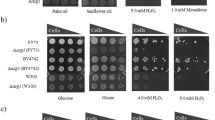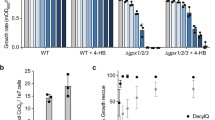Abstract
In yeast, long chain acyl-CoA synthetase (ACSL) activity is required for fatty acid uptake, metabolism and fatty acid-dependent transcriptional control. The major ACSL contributing these functions is Faa1p. In a yeast two-hybrid screen, the Omi/HtrA serine protease family orthologue Ynm3p (YNL123w) was identified as a specific interactor with Faa1p. Interaction of Ynm3p and Faa1p was confirmed by co-immunoprecipitation. Disruption of the YNM3 gene encoding Ynm3p resulted in increased fatty acid uptake, triglyceride accumulation and reduced expression of the fatty acid-responsive OLE1 gene encoding the essential Δ9-acyl-CoA desaturase. These changes were linked with increased Faa1p and Faa4p ACSL activities. We propose that Ynm3p modulates fatty acid metabolism and gene regulation through negative regulation of ACSL activity. Additional strain-specific phenotypes associated with deletion of YNM3 included inability to grow on non-fermentable carbon sources and altered cellular morphology.







Similar content being viewed by others
References
Bartel PL, Fields S (1997) The yeast two-hybrid system. Oxford University Press, Oxford
Bligh EG, Dyer WJ (1959) A rapid method of total lipid extraction and purification. Can J Biochem Physiol 37:911–917
Bloomfield DK, Bloch K (1958) The role of oxygen in the biosynthesis of unsaturated fatty acids. Biochim Biophys Acta 30:220–221
Briaud I, Harmon JS, Kelpe CL, Segu VB, Poitout V (2001) Lipotoxicity of the pancreatic beta-cell is associated with glucose-dependent esterification of fatty acids into neutral lipids. Diabetes 50:315–321
Chiu HC et al (2001) A novel mouse model of lipotoxic cardiomyopathy. J Clin Invest 107:813–822
Choi JY, Stukey J, Hwang SY, Martin CE (1996) Regulatory elements that control transcription activation and unsaturated fatty acid-mediated repression of the Saccharomyces cerevisiae OLE1 gene. J Biol Chem 271:3581–3589
Clausen T, Southan C, Ehrmann M (2002) The HtrA family of proteases: implications for protein composition and cell fate. Mol Cell 10:443–455
Duronio RJ, Knoll LJ, Gordon JI (1992) Isolation of a Saccharomyces cerevisiae long chain fatty acyl:CoA synthetase gene (FAA1) and assessment of its role in protein N-myristoylation. J Cell Biol 117:515–529
Dyntar D et al (2001) Glucose and palmitic acid induce degeneration of myofibrils and modulate apoptosis in rat adult cardiomyocytes. Diabetes 50:2105–2113
Eisler H, Frohlich KU, Heidenreich E (2004) Starvation for an essential amino acid induces apoptosis and oxidative stress in yeast. Exp Cell Res 300:345–353
Faergeman NJ, DiRusso CC, Elberger A, Knudsen J, Black PN (1997) Disruption of the Saccharomyces cerevisiae homologue to the murine fatty acid transport protein impairs uptake and growth on long-chain fatty acids. J Biol Chem 272:8531–8538
Faergeman NJ, Black PN, Zhao XD, Knudsen J, DiRusso CC (2001) The Acyl-CoA synthetases encoded within FAA1 and FAA4 in Saccharomyces cerevisiae function as components of the fatty acid transport system linking import, activation, and intracellular Utilization. J Biol Chem 276:37051–37059
Fahrenkrog B, Sauder U, Aebi U (2004) The S. cerevisiae HtrA-like protein Nma111p is a nuclear serine protease that mediates yeast apoptosis. J Cell Sci 117:115–126
Giaever G et al (2002) Functional profiling of the Saccharomyces cerevisiae genome. Nature 418:387–391
Gietz RD, Woods RA (2002) Transformation of yeast by lithium acetate/single-stranded carrier DNA/polyethylene glycol method. Methods Enzymol 350:87–96
Golemis EA, Serebriiskii I, Law SF (1999) The yeast two-hybrid system: criteria for detecting physiologically significant protein–protein interactions. Curr Issues Mol Biol 1:31–45
Guldener U, Heck S, Fielder T, Beinhauer J, Hegemann JH (1996) A new efficient gene disruption cassette for repeated use in budding yeast. Nucleic Acids Res 24:2519–2524
Gyuris J, Golemis E, Chertkov H, Brent R (1993) Cdi1, a human G1 and S phase protein phosphatase that associates with Cdk2. Cell 75:791–803
Hanes SD, Brent R (1989) DNA specificity of the bicoid activator protein is determined by homeodomain recognition helix residue 9. Cell 57:1275–1283
Hilt W (2004) Targets of programmed destruction: a primer to regulatory proteolysis in yeast. Cell Mol Life Sci 61:1615–1632
Johnson DR, Knoll LJ, Levin DE, Gordon JI (1994) Saccharomyces cerevisiae contains four fatty acid activation (FAA) genes: an assessment of their role in regulating protein N-myristoylation and cellular lipid metabolism. J Cell Biol 127:751–762
Jollow D, Kellerman GM, Linnane AW (1968) The biogenesis of mitochondria. 3. The lipid composition of aerobically and anaerobically grown Saccharomyces cerevisiae as related to the membrane systems of the cells. J Cell Biol 37:221–230
Jones JM et al (2003) Loss of Omi mitochondrial protease activity causes the neuromuscular disorder of mnd2 mutant mice. Nature 425:721–727
Knoll LJ, Johnson DR, Gordon JI (1995) Complementation of Saccharomyces cerevisiae strains containing fatty acid activation gene (FAA) deletions with a mammalian acyl-CoA synthetase. J Biol Chem 270:10861–10867
Lagunas R (1986) Misconceptions about the energy metabolism of Saccharomyces cerevisiae. Yeast 2:221–228
Lee Y, Hirose H, Ohneda M, Johnson JH, McGarry JD, Unger RH (1994) Beta-cell lipotoxicity in the pathogenesis of non-insulin-dependent diabetes mellitus of obese rats: impairment in adipocyte-beta-cell relationships. Proc Natl Acad Sci USA 91:10878–10882
Letunic I et al (2004) 6SMART 4.0: towards genomic data integration (database issue). Nucleic Acids Res 32:D142–D144
Li X, Melamed MR, Darzynkiewicz Z (1996) Detection of apoptosis and DNA replication by differential labeling of DNA strand breaks with fluorochromes of different color. Exp Cell Res 222:28–37
Li W et al (2002) Structural insights into the pro-apoptotic function of mitochondrial serine protease HtrA2/Omi. Nat Struct Biol 9:436–441
Li H, Black PN, DiRusso CC (2005) A live-cell high-throughput screening assay for identification of fatty acid uptake inhibitors. Anal Biochem 336:11–19
Listenberger LL, Ory DS, Schaffer JE (2001) Palmitate-induced apoptosis can occur through a ceramide-independent pathway. J Biol Chem 276:14890–14895
Lowry CV, Zitomer RS (1984) Oxygen regulation of anaerobic and aerobic genes mediated by a common factor in yeast. Proc Natl Acad Sci USA 81:6129–6133
Luo Y, Karpichev IV, Kohanski RA, Small GM (1996) Purification, identification, and properties of a Saccharomyces cerevisiae oleate-activated upstream activating sequence-binding protein that is involved in the activation of POX1. J Biol Chem 271:12068–12075
Madeo F, Frohlich E, Frohlich KU (1997) A yeast mutant showing diagnostic markers of early and late apoptosis. J Cell Biol 139:729–734
Madeo F et al (1999) Oxygen stress: a regulator of apoptosis in yeast. J Cell Biol 145:757–767
Madeo F et al (2002) A caspase-related protease regulates apoptosis in yeast. Mol Cell 9:911–917
Martins LM et al (2004) Neuroprotective role of the reaper-related serine protease HtrA2/Omi revealed by targeted deletion in mice. Mol Cell Biol 24:9848–9862
McHale MW, Kroening KD, Bernlohr DA (1996) Identification of a class of Saccharomyces cerevisiae mutants defective in fatty acid repression of gene transcription and analysis of the frm2 gene. Yeast 12:319–331
Nourry C, Grant SG, Borg JP (2003) PDZ domain proteins: plug and play! Sci STKE 2003:RE7
Pallen MJ, Wren BW (1997) The HtrA family of serine proteases. Mol Microbiol 26:209–221
Rottensteiner H, Kal AJ, Hamilton B, Ruis H, Tabak HF (1997) A heterodimer of the Zn2Cys6 transcription factors Pip2p and Oaf1p controls induction of genes encoding peroxisomal proteins in Saccharomyces cerevisiae. Eur J Biochem 247:776–783
Schaffer JE, Lodish HF (1994) Expression cloning and characterization of a novel adipocyte long chain fatty acid transport protein. Cell 79:427–436
Sheng M, Sala C (2001) PDZ domains and the organization of supramolecular complexes. Annu Rev Neurosci 24:1–29
Sikorski RS, Hieter P (1989) A system of shuttle vectors and yeast host strains designed for efficient manipulation of DNA in Saccharomyces cerevisiae. Genetics 122:19–27
Stith BJ, Hall J, Ayres P, Waggoner L, Moore JD, Shaw WA (2000) Quantification of major classes of Xenopus phospholipids by high performance liquid chromatography with evaporative light scattering detection. J Lipid Res 41:1448–1454
Struhl G, Struhl K, Macdonald PM (1989) The gradient morphogen bicoid is a concentration-dependent transcriptional activator. Cell 57:1259–1273
Unger RH (1995) Lipoto6xicity in the pathogenesis of obesity-dependent NIDDM. Genetic and clinical implications. Diabetes 44:863–870
Unger RH (2002) Lipotoxic diseases. Annu Rev Med 53:319–336
Unger RH, Orci L (2000) Lipotoxic diseases of nonadipose tissues in obesity. Int J Obes Relat Metab Disord 24:S28–S32
Verhagen AM et al (2002) HtrA2 promotes cell death through its serine protease activity and its ability to antagonize inhibitor of apoptosis proteins. J Biol Chem 277:445–454
Zhang S, Skalsky Y, Garfinkel DJ (1999) MGA2 or SPT23 is required for transcription of the delta9 fatty acid desaturase gene, OLE1, and nuclear membrane integrity in Saccharomyces cerevisiae. Genetics 151:473–483
Zhang Q, Chieu HK, Low CP, Zhang S, Heng CK, Yang H (2003) Schizosaccharomyces pombe cells deficient in triacylglycerols synthesis undergo apoptosis upon entry into the stationary phase. J Biol Chem 278:47145–47155
Zou Z, Tong F, Faergeman NJ, Borsting C, Black PN, DiRusso CC (2003) Vectorial acylation in Saccharomyces cerevisiae. Fat1p and fatty acyl-CoA synthetase are interacting components of a fatty acid import complex. J Biol Chem 278:16414–16422
Acknowledgements
The authors thank Drs. Michael Fasullo, Steven Hanes, and Randall Morse for helpful discussions and comments on the manuscript. This work was supported by grants from the American Heart Association (AHA 0151215T to CCD and AHA 0315294T, a pre-doctoral fellowship, to FT) and the National Inst6itutes of Health (GM56850 to PNB and CCD).
Author information
Authors and Affiliations
Corresponding author
Additional information
Communicated by S. Hohmann
Rights and permissions
About this article
Cite this article
Tong, F., Black, P.N., Bivins, L. et al. Direct interaction of Saccharomyces cerevisiae Faa1p with the Omi/HtrA protease orthologue Ynm3p alters lipid homeostasis. Mol Genet Genomics 275, 330–343 (2006). https://doi.org/10.1007/s00438-005-0089-1
Received:
Accepted:
Published:
Issue Date:
DOI: https://doi.org/10.1007/s00438-005-0089-1




